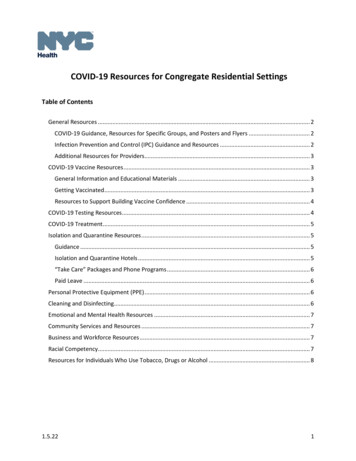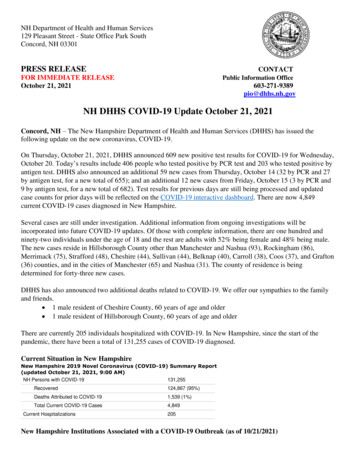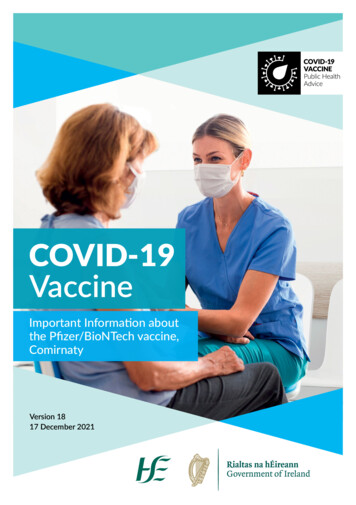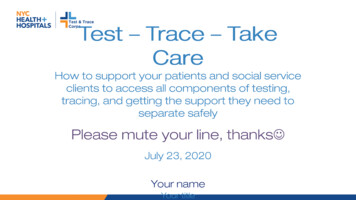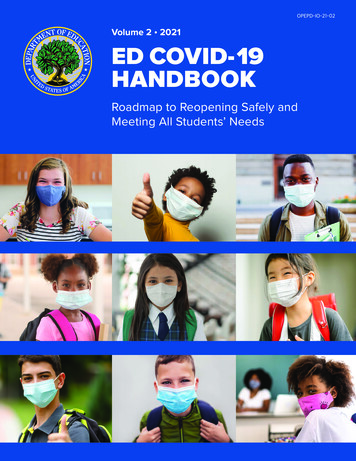
Transcription
OPEPD-IO-21-02Volume 2 2021ED COVID-19HANDBOOKRoadmap to Reopening Safely andMeeting All Students’ NeedsVOLUME 2Roadmap to Reopening Safely andMeeting All Students’ Needs2021i
U.S. Department of EducationDr. Miguel A. CardonaSecretary of EducationOffice of Planning, Evaluation and Policy DevelopmentDonna M. Harris-AikensActing Assistant SecretaryInitially released in April 2021; updated August 2021 The updates included in this Volume of the ED COVID-19 Handbook are based on the mostrecent Centers for Disease Control (CDC) guidance issued as of August 17, 2021. For themost recent CDC guidance issued after the release of this Volume – and how to considerthe strategies included in this resource within the context of the most up to date guidance– please visit: y/schools-childcare/k12-guidance.html. Summary of Recent Changes in August 2021 Update: Revised guidance related to physical health and safety to align with updates to CDCguidance as of the time of the release. For the most recent CDC guidance, pleasevisit: y/schools-childcare/k-12guidance.html.This report is in the public domain. Authorization to reproduce it in whole or in part is granted.While permission to reprint this publication is not necessary, the citation should be U.S. Departmentof Education, Office of Planning, Evaluation and Policy Development, ED COVID-19 Handbook,Volume 2: Roadmap to Reopening Safely and Meeting All Students’ Needs Washington, DC, 2021.This report is available on the Department’s website at g-2.pdf.Availability of Alternate FormatsOn request, this publication is available in alternate formats, such as Braille or large print. For moreinformation, please contact the Department’s Alternate Format Center at 202-260-0818 or viae-mail at alternateformatcenter@ed.gov.Notice to Limited English Proficient PersonsIf you have difficulty understanding English, you may request language assistance services forDepartment information that is available to the public. These language assistance services areavailable free of charge. If you need more information about interpretation or translation services,please call 1-800-USA-LEARN (1-800-872-5327) (TTY: 1-800-877-8339), email us at Ed.Language.Assistance@ed.gov, or write to U.S. Department of Education, Information Resource Center, 400Maryland Ave., SW, Washington, DC 20202.ii
ContentsIntroduction. . . . . . . . . . . . . . . . . . . . . . . . . . . . . . . . . . . . . . . . . . . . . . . . . . . . . . . . . . . . 1I. Creating Safe and Healthy Learning Environments. . . . . . . . . . . . . . . . . . . . . . . . 5a. Meeting basic needs: providing school meals regardlessof educational setting . . . . . . . . . . . . . . . . . . . . . . . . . . . . . . . . . . . . . . . . . . . . . . . . . . 5b. Meeting the social, emotional, and mental health needs of students. . . . . . . . . 8c. Providing all students with access to a safe and inclusivelearning environment. . . . . . . . . . . . . . . . . . . . . . . . . . . . . . . . . . . . . . . . . . . . . . . . . . 12II. Addressing Lost Instructional Time. . . . . . . . . . . . . . . . . . . . . . . . . . . . . . . . . . . . . 18a. Accelerating learning through instructional approaches, tutoring,and expanded learning time . . . . . . . . . . . . . . . . . . . . . . . . . . . . . . . . . . . . . . . . . . . . 18b. Supporting equitable access and effective use of technology. . . . . . . . . . . . . . . 25c. Using data about students’ opportunity to learn to help targetresources and support. . . . . . . . . . . . . . . . . . . . . . . . . . . . . . . . . . . . . . . . . . . . . . . . . 28d. Addressing resource inequities. . . . . . . . . . . . . . . . . . . . . . . . . . . . . . . . . . . . . . . . 32III. Supporting Educator and Staff Stability and Well-Being . . . . . . . . . . . . . . . . . . 38a. Stabilizing a diverse and qualified educator workforce . . . . . . . . . . . . . . . . . . . . 38b. Supporting educator and staff well-being . . . . . . . . . . . . . . . . . . . . . . . . . . . . . . . 42iii
IntroductionCoronavirus Disease 2019 (COVID-19) has exacerbated existing inequities and inadequacies across a rangeof social structures, including our nation’s education system. The pandemic has also had a more damagingimpact on communities and people of color, including many who already faced health challenges. Congresshas provided significant federal funding, including most recently through the historic American Rescue PlanAct of 2021 (ARP), to support the safe reopening of schools. However, this is the first of many steps ahead.For most schools, returning to the status quo will not address the full impact of COVID-19 on students’ social,emotional, physical, mental health, and academic needs or the impact on educator and staff well-being.Approaches to school reopening must be designed in ways that meet the needs of students, educators,and staff. President Joe Biden has called on us all to consider how we can “build back better.” Just as wecontinue to look to the evolving science as we work to reopen schools safely, so too should we turn toresearch and evidence, as well as the voices of students, educators, staff, and their families, to inform effortsto address the social, emotional, mental health, and academic impact of COVID-19.With the passage of ARP, states, districts, and schools now have significant federal resources available toimplement evidence-based and practitioner-informed strategies to meet the needs of students related toCOVID-19, including students most affected by the pandemic and for whom the pandemic exacerbated preexisting inequities. This guidance document is intended to be a resource for states, districts, schools, andteachers as they reopen schools safely and support students. Separately, the Department will issue guidanceon specific provisions of ARP statute and program implementation.Specifically, funding under ARP can be used to: Implement COVID-19 prevention strategies to safely reopen schools and maximize in-personinstruction and that align with public health guidance, including upgrading school facilities for healthylearning environments; Address the impact of lost instructional time by supporting the implementation of evidence-basedinterventions that respond to students’ social, emotional, and academic needs; Address the disproportionate impact of COVID-19 on students of color, students from low-incomebackgrounds, students with disabilities, English learners, students who are migratory, studentsexperiencing homelessness, students in correctional facilities, and students in foster care; Provide afterschool, or other out-of-school time, programs that address students’ social, emotional,and academic needs; Address the mental health needs of students, including through using funds to hire counselors andother staff; Provide integrated student supports, including through the use of full-service community schools; Provide students with evidence-based summer learning and enrichment programs, including throughpartnerships with community-based organizations; Connect K-12 students to high-quality home internet and/or devices; Stabilize and diversify the educator workforce and rebuild the educator pipeline;1
Provide children and youth experiencing homelessness with integrated student support services andassistance with attending school/participating in activities; and Provide for any activities allowed under the Elementary and Secondary Education Act of 1965,as amended (ESEA), the Strengthening Career and Technical Education for the 21st Century Act(Perkins V), and the Individuals with Disabilities Education Act (IDEA).These funds also provide an opportunity to address the most urgent needs of students, teachers, and staffwhile making the kinds of investments that build state, district, and school capacity in ways that sustainmeaningful and effective teaching and learning. If well-invested, funding through ARP can help address gapsin educational opportunity and outcomes — not just during the COVID-19 pandemic, but beyond.As stated in Executive Order 14000, Supporting the Reopening and Continuing Operation of Schools andEarly Childhood Education Providers, every student in America deserves a high-quality education in a safeenvironment. The Biden-Harris Administration (Administration) believes strongly that returning to in-personlearning as soon as possible is essential for all students and families. This is why the Administration movedquickly to release Volume 1: Strategies for Safely Reopening Elementary and Secondary Schools of thisCOVID-19 Handbook to aid educators in implementing the Centers for Disease Control and Prevention (CDC)Operational Strategy for K-12 Schools through Phased Prevention (K-12 Operational Strategy) by addressingcommon challenges and providing practical examples.As stated in Volume 1, the Administration acknowledges the unique impact of COVID-19 on, and traumaexperienced by, underserved students, including students from low-income backgrounds, students of color,lesbian, gay, bisexual, transgender, and queer (LGBTQ ) students, English learners, students with disabilities,migratory students, rural students, American Indian, Alaska Native, Native Hawaiian, and Asian AmericanPacific Islander students, students in foster care, students in correctional facilities, and students experiencinghomelessness. The Administration recognizes that communities of color have borne a disproportionateburden of illness and serious outcomes from COVID-19 and require additional considerations.Volume 2: Roadmap to Reopening Safely and Meeting All Students’ Needs is intended to offerinitial strategies for providing equitable and adequate educational opportunities that address the impactof COVID-19 on students, educators, and staff, focusing on evidence-based strategies for: Meeting students’ social, emotional, mental and physical health, and academic needs, includingthrough meeting basic student needs; reengaging students; and providing access to a safe andinclusive learning environment; Addressing the impact of COVID-19 on students’ opportunity to learn, including closingthe digital divide; implementing strategies for accelerating learning; effectively using data; andaddressing resource inequities; and Supporting educator and staff well-being and stability, including stabilizing a diverse andqualified educator workforce.Within these areas, this volume shares underlying research, implementation recommendations, andconsiderations — with a focus on underserved students — and examples of practice. The U.S. Department ofEducation (the Department) is grateful to the more than 60 education organizations that shared research,recommendations, examples, and resources, as well as the perspectives of students, families, and schoolstaff members, that were used to inform Volume 2 of the COVID-19 Handbook. These recommendationsand resources were submitted through a Department email shared broadly as part of the Department’sstakeholder engagement efforts and listed in Volume 1. The Department also hosted six listening sessionsattended by more than 30 organizations to gather insights into challenges students, educators, and staff2
are facing and promising practices and to make recommendations to address the impact of COVID-19 on theschool community. The research, recommendations, examples, and resources that the Department receivedwill also help inform future guidance and resources issued by the Department.Funding under ARP may be used by states, districts, and schools to ensure that all students have access tothe educational opportunities they need to succeed in response to COVID-19. The same way listening to thescience will lead us out of this pandemic, we must listen to the researchers, the educators, the students andtheir families to lead us to a changed education system that is designed to build capacity, support systems ofcontinuous improvement, and which at its core is committed to equity, adequacy, and the limitless potentialof each and every student.Engaging the School CommunityAs emphasized in Volume 1, as schools and districts work to develop and implement strategies, includingthose included in this Volume, engagement with educators and staff (including their unions), students,families, and the school community is key. School representatives should include, at a minimum,administrators, teachers, specialized instructional support personnel, related service providers, earlychildhood education providers, school counselors, school social workers, school psychologists, and nurses, aswell as custodial personnel, transportation personnel, food personnel, and family services representatives.Strategic planning for the long-term recovery should include student and parent representatives, andindividuals and organizations that represent the interests of students, staff, and parents with disabilities andlimited English proficiency. To that end, schools and school districts should also conduct active and specificengagement with historically underserved students and families — including parents of students of color,English learners, students with disabilities, American Indian, Alaska Native, and Native Hawaiian students,students in foster care, students in correctional facilities, and students experiencing homelessness.For example, in Oak Park, Illinois, a local nonprofit organization, prior to COVID-19, created an approach tofamily engagement and partnered with parent teacher organizations leaders and the district’s Culture andClimate Coaches to launch Come Together, family dinners where teachers, families, and students connectand work to identify and solve challenges in their school over the course of the school year. During thepandemic, the group successfully pivoted to online gatherings, reaching nearly 2,000 participants in aneffort to open dialogue over the issue of remote learning. In the remaining months of the school year, thesevirtual gatherings will focus on transitions and on-going support using community organizing strategies tointentionally reach all families.This engagement should begin early in the decision-making process and should be ongoing andcollaborative. This will help to select strategies designed for systemic change that can build buy-in andcapacity at the local level for the long-term.Legal RequirementsDistricts and schools can use funding under ARP to support the following strategies and interventions toaddress the impact of COVID-19, consistent with ARP requirements and the Uniform Guidance in 2 CFRPart 200. Other than statutory and regulatory requirements referenced in the document, the contentsof this volume do not have the force or effect of law and do not bind the public and school communities.This document is intended only to provide clarity regarding existing requirements under the law or agencypolicies. Further, this document does not substantively address federal disability law, which requiresschools to provide certain educational and related services to students with disabilities and to take anindividualized approach to providing specialized instruction and related services, consistent with the3
student’s individualized education program (IEP) developed under IDEA or plan developed under Section504 of the Rehabilitation Act of 1973 (504 plan), as appropriate. Additional guidance on these issues maybe provided. For information on the rights of students with disabilities and schools’ obligations, please referto information provided by the Department’s Office of Special Education and Rehabilitative Services andOffice for Civil Rights. Please also refer to the Department’s COVID-19 Resources for Schools, Students, andFamilies.Legal DisclaimerThis document contains resources (including links to those resources) that are provided for the user’sconvenience. Inclusion of these materials is not intended to reflect their importance, nor is it intended toendorse any views expressed or products or services offered. These materials might contain the views andrecommendations of various subject-matter experts, as well as hyperlinked text, contact addresses, andwebsites to information that other public and private organizations created and maintain. The opinionsexpressed in any of these materials do not necessarily reflect the positions or policies of the Department.The Department does not control or guarantee the accuracy, relevance, timeliness, or completeness ofany outside information included in these materials. For the reader’s convenience, this document containsexamples of potentially useful resources and methodologies states and localities use. Inclusion of suchinformation does not constitute an endorsement by the Department or the federal government, nor apreference or support for these examples as compared with others that might be available and be presented.4
I. Creating Safe and Healthy Learning Environmentsa. Meeting basic needs: providing school meals regardless of educational settingHealthy eating is important for child and adolescent growth, development, well-being, and academicperformance. According to the National School Lunch Program, before COVID-19, about 22 million studentsreceived free or reduced-priced lunches each day — providing them with access to this basic need. Infact, children consume as many as half of their daily calories at school. When the pandemic-related schoolclosures began in March 2020, schools quickly realized that this could threaten or eliminate students’ accessto school nutrition services — even if districts used hybrid approaches to learning — and significantly affectschools’ ability to meet this basic need.In response, the United States Department of Agriculture (USDA) provided flexibilities and waivers includingallowing meals to be served in a drive-thru or walk-up setting, offered as “grab-and-go” meals. Multiplemeals (i.e., breakfast, lunch, snack, and dinner) can be provided as well as multiple days’ worth of meals at atime, regardless of whether they are tied to an educational or enrichment activity, and meals can be providedto parents or guardians without the presence of a child. School districts have taken advantage of theseflexibilities and established various creative food distribution models, including curbside distribution, homedelivery, school bus route delivery, and delivery to accessible community locations (such as library parkinglots) during remote or hybrid instruction. These new strategies enhanced schools’ abilities to provide thiscritical resource to students and families. Information on waivers and flexibilities that have been approvedcan be found on the Child Nutrition Programs: COVID-19 Waivers by State webpage.As more schools plan for reopening, feeding and food distribution will continue to be essential. Schoolnutrition staff, school nurses, and transportation staff are vital members of the district and school reopeningteams. Where fewer meals have been provided, there might be less money from federal reimbursements anddecreased revenue from a la carte services. School leaders should communicate with nutrition directors toassess how the meal programs are faring financially and plan for ways to address any challenges exacerbatedby the pandemic, including using federal funding provided under ARP, the Coronavirus Response and ReliefSupplemental Appropriations Act (CRRSA), and the Coronavirus Aid, Relief, and Economic Security Act(CARES Act).As part of these plans, districts and schools will also need to implement COVID-19-related safety protocolsfor food distribution. CDC provides online resources for safely distributing school meals, either away fromschool or in school, including a checklist for school nutrition professionals for serving meals at school andstrategies for reducing crowding, increasing ventilation, and serving grab-and-go meals. Detailed informationon COVID-19-adapted school meal serving models and adapting school spaces can be found on CDC’s SafelyDistributing School Meals During COVID-19 webpage.Meal programs should be tailored to meet the local community and individual school needs. Learning aboutthese needs might include conducting family surveys to inform distribution of meal kits (e.g., whetherstudents pick up meals for a week or two days at a time, the time of day meals are available for pick up,and whether a grab-and-go service, delivery services, or some combination would be most effective) andensure they are responsive to dietary restrictions. School leaders should design a variety of distribution mealschedules to ensure equity among recipients. For example, following a consistent alphabetical format mightplace families with surnames in the second half of the alphabet at a disadvantage in terms of availabilityof food items. Meal service plans should ensure there is adequate staff available on a sufficiently flexibleor extended schedule (with appropriate compensation or use of volunteers) to maintain services forhybrid or remote students (e.g., bagging meals, staffing grab-and-go sites), while also staffing kitchens forin-person students.5
As districts and schools plan for summer learning and enrichment programs, they should also develop aplan to provide meal programs in non-school settings. On March 9, 2021, USDA announced the nationwideextension of several waivers that allow all children to continue to receive nutritious meals during thesummer and that allow for safe meal distribution sites that serve all children for free regardless of familyincome. These flexibilities have been extended through September 30, 2021. In addition, USDA is expandingthe Pandemic Electronic Benefit Transfer (P-EBT) program to support families with lower incomes withchildren and replace the value of school meals missed when schools are closed. On January 22, 2021, USDAannounced that it would increase the P-EBT benefit by approximately 15%. In addition, ARP expanded P-EBTthrough the 2020-2021 school year, as well as during summer months.As an example of how one state has approached this effort, the Tennessee School Safety Center establishedprinciples at the onset of the pandemic for developing a school meal plan. These principles include involvingthe community in school nutrition strategies, including community organizations, such as afterschoolprograms, shelters, local safety personnel and emergency managers, and transportation directors; identifyingimportant safety protocols in food distribution, even after schools reopen; forecasting operational needs for30, 60, and 90 days; organizing the work and determining clear lines of responsibility; and analyzing lessonslearned during the pandemic and updating plans to incorporate those lessons learned.Meal planning should include an ongoing assessment of the needs of underserved students, includingstudents not attending in-person instruction for the full five days per week, highly mobile students, such asstudents experiencing homelessness, migratory and foster youth, students who have become disengaged,and populations with limited food resources or restricted dietary requirements.Additional suggestions for meeting the nutritional needs of underserved students include: Working with the state nutrition agency to determine how to provide students with free mealsduring afterschool and summer learning and enrichment programs, including through the USDAAfterschool Program and Summer Food Service Program. Providing information and maps of meal sites in multiple languages and in multiple accessibleformats (e.g., social media, flyers, phone calls, community listservs) and distributing informationthrough partners (e.g., government agencies, local nonprofit organizations, places of worship) takinginto consideration that some families might be reluctant to access meal programs and services (e.g.,families with a member without documentation). Supporting families in accessing meals during hybrid learning and during non-school days, such asweekends and holidays. For example, through the P-EBT, funds are provided on pre-loaded cards tofamilies of children who would normally receive free or reduced-price meals. Partnering with local food banks and pantries to provide boxes of groceries along with meals or withChild and Adult Care Food Program (CACFP) operators to offer CACFP foods along with meals. Establishing school-based wellness teams comprised of representatives from administration,teachers, counseling, nursing, and support staff to ensure all families in need are identified andprovided with resources to access food and meals. For example, team members could be assigned tofamilies as “case managers” to identify specific needs and to ensure families have access to nutritiousmeals and food. Where applicable and to increase the reach of services, decentralizing food preparation anddistribution by activating multiple school kitchens and delivering meals to school bus stops ordirectly to students’ homes.6
Creating schedules that provide families with equitable access to food distribution and flexibility inschedule to provide time offerings that are conducive to working families. Food distribution shouldnot be limited to school hours. Providing flexible pick-up hours to maximize access to meals at strategically located meal pick-upsites. Provide meal packages with multiple days’ worth of meals. For in-school meals, allow studentsaccess to breakfast meals even after the morning bell, including by allowing students to bring graband-go meals into the classroom. Staffing delivery buses with school nurses, counselors, and social workers. School leaders should bemindful of the potential impact of enlisting police officers to assist with meal site logistics (i.e., thesight of police might elicit fear in some families). Ensuring that liaisons for students experiencing homelessness and personnel serving students withdisabilities have the information they need to ensure students can access food inside and outsideof school and to provide training to school district staff or community members on identifying andserving students experiencing homelessness or students with disabilities. Ensuring policies do not prevent or delay providing free meals to students due to unpaid fees.7
b. Meeting the social, emotional, and mental health needs of studentsMany students have been exposed to trauma, disruptions in learning, physical isolation, and disengagementfrom school and peers, which negatively affects their mental health. Students learn, take academic risks, andachieve at higher levels in safe and supportive learning environments and in the care of responsive adultsthey can trust. However, the ongoing impact of COVID-19 has contributed to student experiences that arefar from universal — with underserved students experiencing a disproportionate burden of the pandemic. Asa result, many students might require additional supports and interventions to take risks in their learning sothey can achieve at higher levels.Homelessness, foster care, and juvenile justice are adverse experiences that might disproportionately affectstudents from low-income backgrounds, students of color, English learners, and students with disabilities.These adverse experiences may also create unique and severe barriers to access and participation inprograms and services. School leaders, educators, and staff who work with students with these backgroundsshould acknowledge the intersectionality (the overlapping identities) among these groups. This framing willhelp educators understand the multiple layers of disparities and complexities encountered by impactedstudents and the mobile and changing nature of homelessness, foster care, and the juvenile justice systemand the disproportionate impact that COVID-19 has had on these students.Research on the science of learning has established that while adverse experiences can have profoundeffects on students, learning environments and conditions can be designed in ways that that can helpstudents overcome these effects and thrive. This research also shows that social, emotional, identity,cognitive, and academic development are all interconnected. Improving academic outcomes for studentsrequires nurturing each of these areas of development in ways that are asset-oriented and personalizedto meet students where they are as they return to school. For example, California provides resources forcreating asset-based approaches to teaching, such as culturally responsive pedagogy.While there is concern regarding the impact of lost instructional time as it relates to student academicperformance, meeting the social and emotional needs of students must be foundational to efforts toimprove academic outcomes for students. The teaching of social and emotional skills can be woven intohow teachers design instruction and the kinds of learning opportunities they provide to students. Suchlearning can be developed through explicit instruction in social, emotional, and cognitive skills (includingintrapersonal and interpersonal skills, conflict resolution, and decision-making) and integrating social andemotional skills, habits, and mindsets within classroom lessons and activities. For example, Baltimore CityPublic Schools built upon existing social and emotional learning implementation efforts and developed socialemotional learning (SEL) lesson plans aligned with grade groupings and weekly themes around compassion,connection, and courage.Key evidence-based practices that maximize students’ social, emotional, and academic benefits include: Creating a framework for meeting students’ social, emotional, and academic needs; Building strong and trusting relationships among students, families, and educators; Establishing safe, positive, and stable environments; Exp
reopening-2.pdf. Availability of Alternate Formats On request, this publication is available in alternate formats, such as Braille or large print. For more information, please contact the Department's Alternate Format Center at 202-260-0818 or via e-mail at alternateformatcenter@ed.gov. Notice to Limited English Proficient Persons








